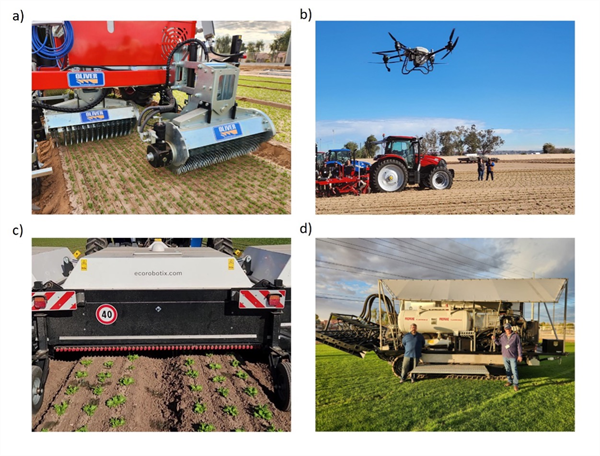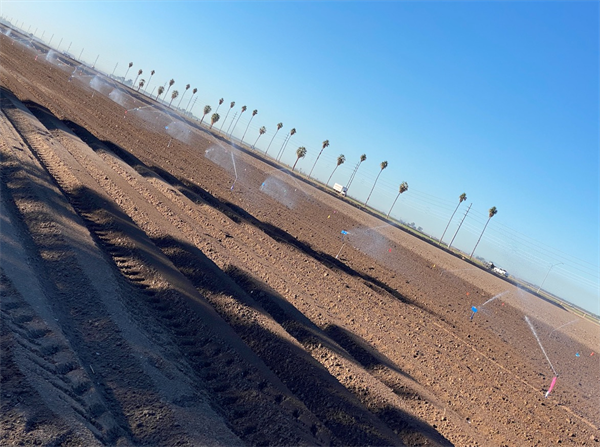
In arid and semi-arid regions, water is our first limiting factor in a crop production system, followed closely by bio-available nitrogen (N). Thus, our management of water and N are critically important to produce a healthy crop with good yields and quality.
Water and nutrient demands coincide with the fruiting cycle and efficient management of irrigation water and plant nutrients is enhanced by tracking crop development in the field. The use of heat units (HUs) with 86/55 oF upper and lower thresholds can be applied to warm season crops in the desert Southwest in relation to the thermal environmental impacts on the development of all crop systems (Brown, 1989), including chiles, (Figures 1 and 2).
Crop Phenology Relationship to Water and Nitrogen Demand
Phenological guidelines have been developed for many crops, including New Mexico type chiles (Soto-Ortiz and Silvertooth, 2007 and Silvertooth, et al, 2010; Figure 1). This phenological guideline can be used to identify or predict important stages of crop development that impact physiological requirements. For example, a phenological guideline can help identify stages of growth in relation to crop water use (consumptive use) and nutrient uptake patterns (Figure 3).
This information allows growers to improve the timing of water and N inputs to improve production efficiency. For some crops or production situations HU based phenological guidelines can be used to project critical dates such as harvest or crop termination. Many other applications related to crop management (e.g., pest management) can be derived from a better understanding of crop growth and development patterns.

Figure 1. Typical relationship between the rate of plant growth and development
and temperature. Growth and development ceases when temperatures decline
below the lower temperature threshold (A) or increase above the upper
temperature threshold (C). Growth and development increases rapidly when
temperatures fall between the lower and upper temperature thresholds (B).

Figure 2. Basic phenological guideline for irrigated New Mexico-type chiles.
References
Brown, P. W. 1989. Heat units. Bull. 8915, Univ. of Arizona Cooperative Extension, College of Ag., Tucson, AZ.
Silvertooth, J.C., P.W. Brown, and S. Walker. 2010. Crop Growth and Development for Irrigated Chile (Capsicum annuum). University of Arizona Cooperative Extension Bulletin No. AZ 1529
Soto-Ortiz, R. and J.C. Silvertooth. 2007. A Crop Phenology Model for Irrigated New Mexico Chile (Capsicum annuum L.) The 2007 Vegetable Report. Jan 08:104-122.
I hope you are frolicking in the fields of wildflowers picking the prettiest bugs.
I was scheduled to interview for plant pathologist position at Yuma on October 18, 2019. Few weeks before that date, I emailed Dr. Palumbo asking about the agriculture system in Yuma and what will be expected of me. He sent me every information that one can think of, which at the time I thought oh how nice!
When I started the position here and saw how much he does and how much busy he stays, I was eternally grateful of the time he took to provide me all the information, especially to someone he did not know at all.
Fast forward to first month at my job someone told me that the community wants me to be the Palumbo of Plant Pathology and I remember thinking what a big thing to ask..
He was my next-door mentor, and I would stop by with questions all the time especially after passing of my predecessor Dr. Matheron. Dr. Palumbo was always there to answer any question, gave me that little boost I needed, a little courage to write that email I needed to write, a rigid answer to stand my ground if needed. And not to mention the plant diagnosis. When the submitted samples did not look like a pathogen, taking samples to his office where he would look for insects with his little handheld lenses was one of my favorite times.
I also got to work with him in couple of projects, and he would tell me “call me John”. Uhh no, that was never going to happen.. until my last interaction with him, I would fluster when I talked to him, I would get nervous to have one of my idols listening to ME? Most times, I would forget what I was going to ask but at the same time be incredibly flabbergasted by the fact that I get to work next to this legend of a man, and get his opinions about pest management. Though I really did not like giving talks after him, as honestly, I would have nothing to offer after he has talked. Every time he waved at me in a meeting, I would blush and keep smiling for minutes, and I always knew I will forever be a fangirl..
Until we meet again.
At the 2024 Southwest Ag Summit Field Demo a couple of weeks ago, many of the latest technologies were demonstrated in the field. Most were related to pest control. Several of the technologies demonstrated or on display at the event are brand new to the Yuma, AZ area. The new technologies presented included an implement designed for cultivating high density crops (Fig. 1a), a field scale drone sprayer (10.6 gal) (Fig. 1b), a high precision spot sprayer (Fig. 1c) and a self-propelled machine that disinfests soil prior to planting using steam. Updated versions of laser weeders, camera-guided cultivators and smart, automated in-row weeding machines (mechanical) were also demonstrated. Over the next several years, it will be interesting to watch the technologies in this space evolve further and become integrated into our cropping systems.

Fig. 1. New pest control technologies demonstrated/on display at the 2024
Southwest Ag Summit Field Demo included a) Oliver1 high density cultivator b)
DJI Agrospray T40 drone sprayer c) Ecorobotix ARA high precision spot sprayer
and d) UC Davis/University of Arizona self-propelled steam applicator for
disinfesting soil prior to planting.
[1] Reference to a product or company is for specific information only and does not endorse or recommend that product or company to the exclusion of others that may be suitable.
The Yuma IPM Team has received requests for herbicide efficacy data generated locally for Onion and Broccoli.
We are currently doing some evaluations for direct seeded broccoli. Some of the treatments suggested by PCAs and growers are Devrinol DF XT at the rate of 1.0 and 2.0 lb, also Devrinol 2-XT at the rate of 1.0 and 2.0 qt. Additional preemergence herbicides included in the trials are Prefar 6 qt, Trifluralin 1.5 pt. Other treatments included are Goal Tender and Prowl with a directed application at 3-5 leaves. In a separate broccoli test we are looking at different incorporation timings of Devrinol due to some stunting issues reported. Our trial includes 12, 24, 36 hour sprinkler irrigation incorporation times for the liquid and dry formulations. Phytotoxicity will be evaluated and reported to you in this newsletter and University of Arizona Workshops.
For onions we established trials including treatments suggested such as Ethotron SC at 32 fl oz to a fine soil. Also included Prefar, Dual Magnum and Treflan preemergence. We will compare with Outlook plus Prowl and Goal Tender at 3 leaf stage.
Additionally, Corteva Agriscience is also focused in providing some options for weed control in both broccoli and onions. Some of their products been evaluated at the Agricultural Center are Rinskor (Hulk) and Enversa at post and preemergence.
We thank you for your treatment suggestions, which are incredibly helpful for designing the experiments we are conducting. We are looking forward to sharing the results with you.
